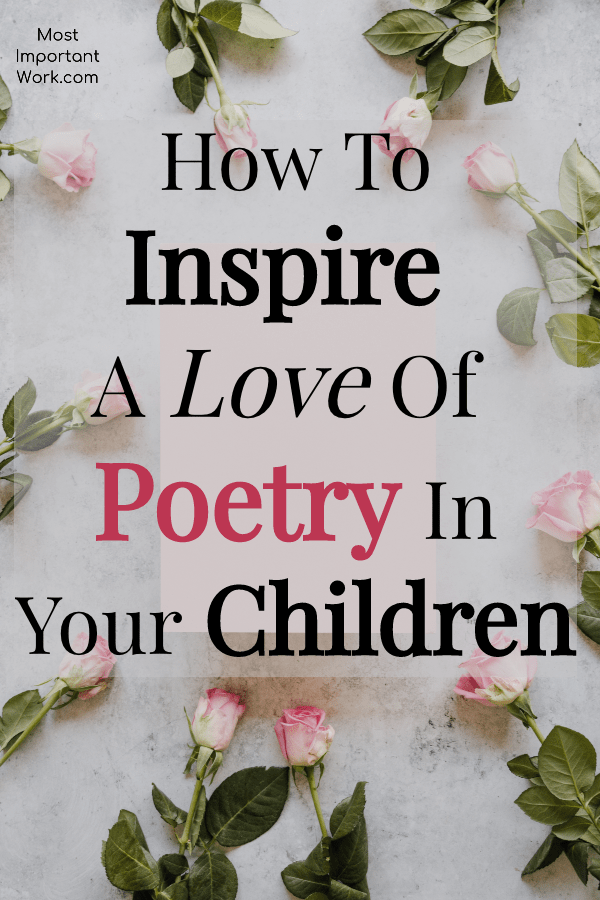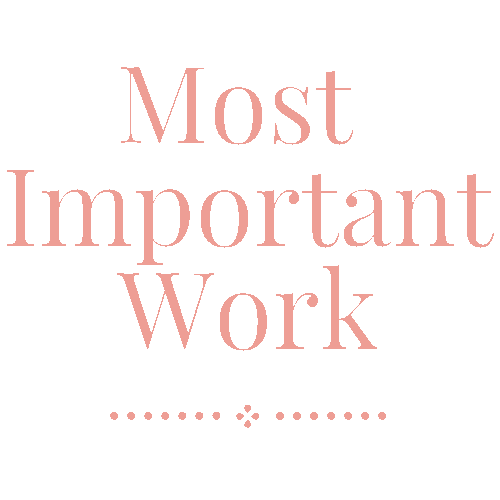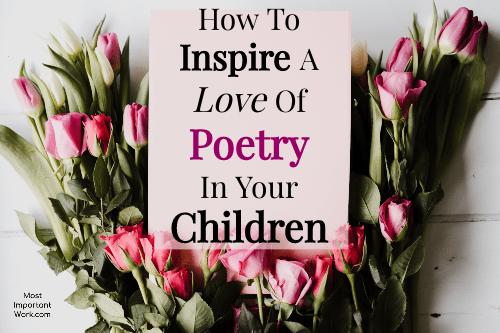Reading Time: 4 min 57 sec
This month in prep for Valentine’s Day, we will be talking about the ins and outs of children’s poetry. Have you ever felt intimidated at the thought of teaching poetry to your children? Me too! I have found that though I love the idea of poetry, actual comprehension and enjoyment has escaped me most of my life.
Poetry can feel like a dreaded acquaintance. You know, that person who tries to impress us with their vast knowledge of the complexities of the English language? After every conversation, you walk away feeling exhausted, the frustration of “why don’t you just say what you mean?” still spinning in your head.
I blame Anne of Green Gables among many others with my fascination with poetry. In the opening scene of Anne of Green Gables, the mini-series, you see her walking through a forest quoting The Lady of Shallot, with such rapt attention, that you can’t help but be intrigued.
“There she weaves by night and day A magic web with colors gay. She has heard a whisper say, A curse is on her is she stay To look down to Camelot She knows not what the curse may be, And so she weaveth steadily, And little over care hath she, The Lady of Shalott.”
-Alfred Lord Tennyson
Poetry gave Anne a voice, a way of embracing beauty in an otherwise dreary existence. She showed us that beautiful words woven together could spark imagination, and produce great emotion in the hearts of its readers.
Several years ago, I knew I wanted to introduce my children to the art of poetry, but I had absolutely no idea how to go about it. I had made a lot of mistakes. Looking back, I feel bad for my poor children (don’t worry this story has a happy ending) after all the shenanigans I put them through.
Years later, despite our misadventures, I now have children who love poetry, to the point where they are starting to write their own. WIN! When it comes to kid’s poetry here are four-time tested ways to help your child embrace a love of poetry.
1. Know Your Audience
2. Consistency Is Key
3. Golden Resources
4. Spark Wonder

1. Know Your Audience
The wonderful thing about poetry is that it is not age-specific. Meaning, you can start by introducing your baby to poetry right now! 🙂 Children have a natural appreciation for the cadence of poetry. All you have to do is listen to them playing hopscotch or jump rope and you will know what I mean.
When I decided that we needed to add poetry into our homeschool day, it was full speed ahead. I started reading poems aloud several times a week. The books I chose were excellent, age-appropriate, and beautiful… for another child.
You see I had failed to consider the uniqueness of my children. I was in such a rush to introduce them to the finest pieces of poetry, that I forgot that beautiful words, at this age, mean nothing, if they aren’t interesting, or if they aren’t understandable.
Poetry should be enjoyed, it should spark a memory of laughter, delight, and imagination. A huge red flag that something is wrong is when it becomes just another thing to check off the to-do list.
I had to stop and realign my expectations with my goal. The goal was to develop a love for poetry, not read all the classics before the age of seven. 🙂 So that meant, focusing on funny, short, poems that centered around topics that were interesting to them. We also read a lot of picture books that were written in verse form which eased our transition into more formal poetry.
2. Consistency Is Key
One way to set yourselves up for success is by choosing a time when your children are most engaged to explore poetry. We focus on poetry one day per week and then sprinkle it in whenever we have time. That consistency has been an integral part of developing a love of poetry. The children know what to expect and it becomes a natural part of our rhythm as a family.
I have also found that giving them something to do with their hands really helps them pay attention. We either utilize Poetry Tea Time (more on that later) or I pull out fidgets, coloring books, or K-nex as a way to keep those little hands busy.
I would encourage you to ask yourself a couple of questions:
a. Do I have any unrealistic expectations when it comes to poetry?
b. What topic(s) most enthrall my children?
c. What is the best time (time of day/day of the week) to introduce my child to poetry?
3. Golden Resources
When you are first starting out, poetry can feel like a chore, until you find the right resource. I started reading so many poetry books only to put them down because they didn’t meet our requirements. I cannot stress this enough, sparking a love of poetry in your child is more important than finishing a resource.
Here is what we were looking for in a poetry book:
a.) Short poems (one page in length)
b.) Understandable rhyme
c.) Captivating Illustrations
d.) Interesting or fun topics
That doesn’t sound that complicated but we went through a huge stack of poetry books before we found one that truly fit us. For instance, the series Poetry for Young People is amazing (we love it now) but not the best fit for early elementary age children.
The day we found a poetry book that fit our family it was like a light bulb went off. My children wanted to read it EVERY SINGLE DAY!
One of those books is Laura Ingalls’s Wilder’s Fairy Stories. It is by far my favorite poetry book for kids. It is a small collection of fairy poems with beautiful illustrations. This is a must have for our personal library! The words are so captivating that my children instantly fell in love with this book.
4. Spark Wonder
One of my favorite ways to include poetry in our weekly rhythm is through Poetry Tea Time. This is a magical time that sparks wonder, delight, and amazing family memories. Each week, we gather together to eat yummy food and drink hot chocolate as we read and discuss poetry. The addition of snacks fosters the idea that reading poetry together is special.
Poetry Tea Time can be as formal or informal as you desire. When my kids were younger, they would arrive in full costume, ready to participate in a formal tea.
I have hosted Poetry Tea Times for penguins, pirates, knights, and princesses.
There was a time when I never really knew who was going to be showing up to tea. And by celebrating poetry through pomp and circumstance we have created lifelong family memories. WIN!
I make a conscious effort to read poems slowly and with emotion. At the end of every reading, we take a couple of minutes to wonder about the poem. We might wonder about the characters, the setting, the author. We might talk about a word or phrase that caught our attention, what emotions the poem sparked, and what we might add to the story.
This is an organic discussion, meaning I never drag it out, some conversations last three minutes others last longer. I have found that when my children enjoy poetry, they take the lead on diving deeper into what we are reading. They have memorized, recited, illustrated, and wrote stories that are based on the poems they have enjoyed.
When you take the time to know your audience, set realistic time limits, find those golden resources, and spark wonder you might be surprised at how poetry isn’t intimidating at all. 🙂
You can grab your own copy of Laura Ingalls Wilder’s Fairy Poems for your collection here. It is a book you will be reading to your grandchildren.
Are you wondering HOW do you actually get started homeschooling? Join our community of moms who want to invest in the lives of their children through homeschooling. I also created a 10 Tips to Finding Excellent Curriculum form to help you on your journey.
What about you? What are your favorite ways to foster a love of poetry in your home? Leave a comment, and don’t forget to follow Most Important Work on Pinterest!
Latest posts by Most Important Work (see all)
- 3 Steps To A Spectacular Kid’s Ministry Group That Matters - May 31, 2024
- 14 Powerful Picture Books That Will Ignite Your Child’s Faith - May 31, 2024
- 7 Powerful Scriptures You Need To Pray Over Your Kids - October 26, 2020



These are such great recommendations! One easy way we’ve incorporated more poetry in our days is the Daily Poem podcast. Each day the host shares a different poem. The variety is excellent. He reads the poem through once, offers some very brief remarks, and then reads it again. Each episode is only about five minutes long, and the podcast format makes it easy to play my kids’ favorite poems over and over again.
I love the idea of a poetry podcast! Thank you for sharing. I can’t wait to check it out! 🙂
[…] is simple, imaginative. and colorful. It struck delight in the hearts of my children. You can check out this article to find out my requirements for choosing beautiful poetry […]